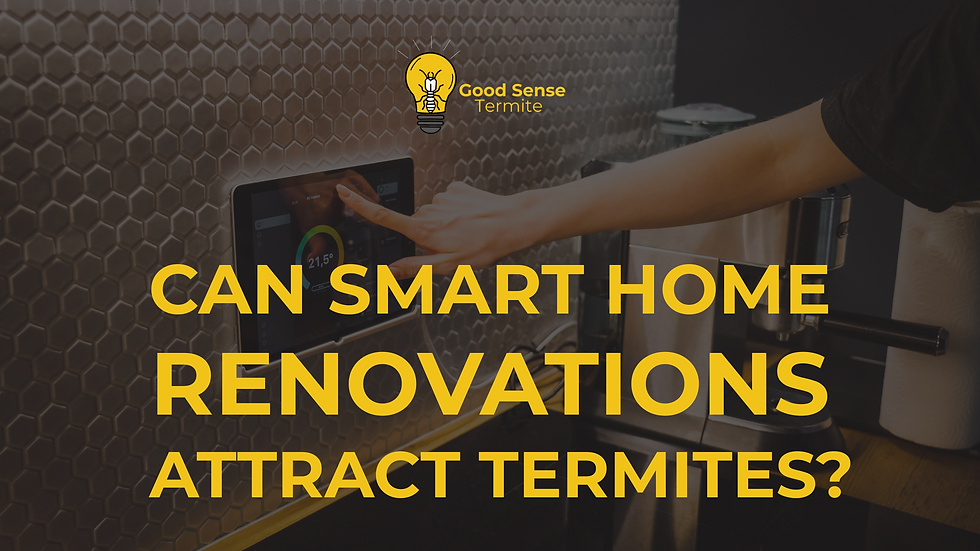Are Tech Renovations Attracting Termites? How Smart Home Upgrades Can Backfire
- Lauren Willard
- Jul 22
- 3 min read

Introduction
The Bay Area leads the nation in smart home renovations—solar panels, EV chargers, battery walls, smart irrigation, and energy-efficient retrofits are becoming the new normal. But here's what homeowners and contractors often overlook:
Many modern upgrades compromise the termite defenses of your home.
Yes, even eco-friendly, high-tech additions can backfire—by creating entry points, moisture traps, or food sources for destructive pests.
This post breaks down:
How popular tech upgrades invite termite infestations
Real-world Bay Area examples of post-renovation termite damage
Prevention strategies that protect both your home and your smart investment
Smart Upgrades = Dumb Entry Points (If You're Not Careful)
1. EV Chargers and Conduit Penetrations
Installing a wall-mounted EV charger often involves drilling through exterior stucco or siding—sometimes near the ground.
Problem: Small gaps around conduits are rarely sealed properly, allowing termite entry into wall voids. Moisture from condensation can also attract subterranean termites.
2. Solar Panels and Roof Penetrations
Solar installations involve lag bolts drilled into roof rafters or sheathing.
Problem: Minor leaks or inadequate flashing create moisture intrusions, which soften wood and attract termites, especially Drywood species. We’ve seen colonies nesting just inches below solar arrays.
3. Smart Irrigation Systems
Automated sprinklers and drip systems optimize water use—unless they overwater.
Problem: Many smart systems are set to water based on air temps, not soil moisture. This leads to constant damp soil, especially around foundations and crawl space vents.
4. Battery Walls or Backup Systems
Mounted in garages or utility rooms, these often require new drywall framing, plywood backing, or electrical boxes.
Problem: Untreated wood is commonly used behind battery units. Once hidden, it creates a perfect, dark, undisturbed feeding ground.
Real Case: Termites Post-Tech in San Jose
A homeowner in the 95136 ZIP installed solar panels, a Tesla Powerwall, and a smart irrigation system within 6 months. Nine months later, Drywood termite pellets began appearing inside the home.
Inspection Findings:
Moisture intrusion around roof mounts
Drip line too close to foundation
Unsealed garage conduit for Powerwall wiring
Treatment + Repair Total: $11,300
How to Prevent Tech Upgrades From Inviting Termites
Involve a Termite Pro During Renovations
Before your contractor drills into siding or roofing, get a termite expert to flag vulnerable areas.
Use Treated Wood Behind Walls or Battery Units
Any plywood or framing used near foundation slabs should be pressure-treated.
Seal All Utility Penetrations with Termite-Resistant Materials
Silicone caulk and backer rod aren't enough—use borate-treated sealants where possible.
Monitor Moisture After Smart Irrigation Installation
Place sensors in the soil near foundations—not just the lawn. Turn off zones if readings stay high.
FAQ
Q: Should I get a termite inspection after installing solar panels?
A: Yes. Any time the roof is penetrated, there’s a chance of moisture leaks. An inspection helps catch hidden risks early.
Q: What kind of wood should be used behind Powerwalls or panels?
A: Pressure-treated or borate-treated plywood is ideal. Never use untreated wood near slabs or crawl spaces.
Q: Do termites eat through electrical wiring?
A: Not typically. But they can enter through unsealed conduits or wall voids created during installations.
Final Thoughts: Tech Is Smart—But Only if You Defend It
High-efficiency homes are the future—but that doesn’t mean they’re automatically safe from nature’s oldest pest. Many Bay Area homeowners are unknowingly creating termite highways in the name of innovation.
Before you drill, mount, or automate—talk to a termite pro. It’s the smartest upgrade you can make.




Comments